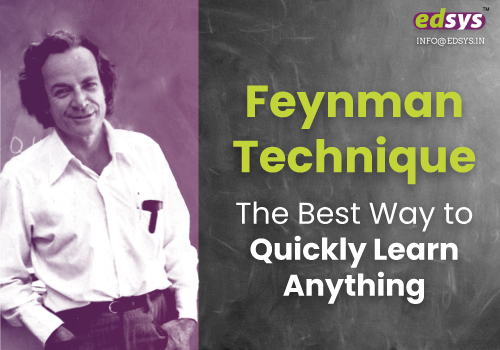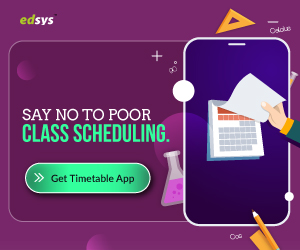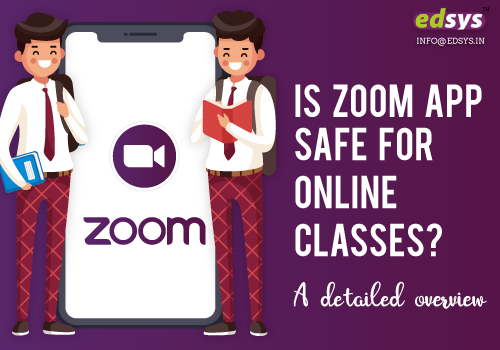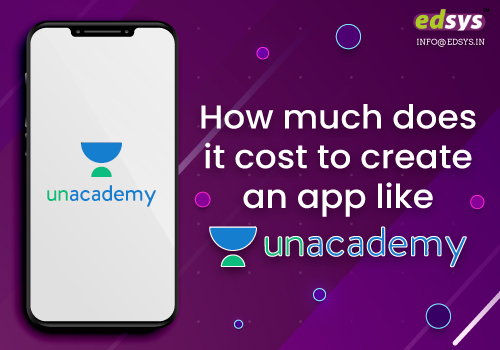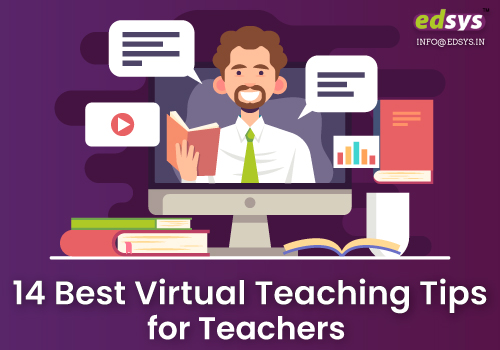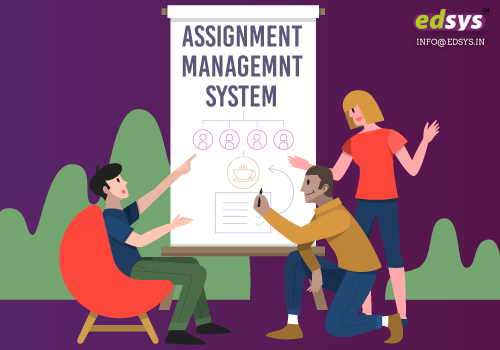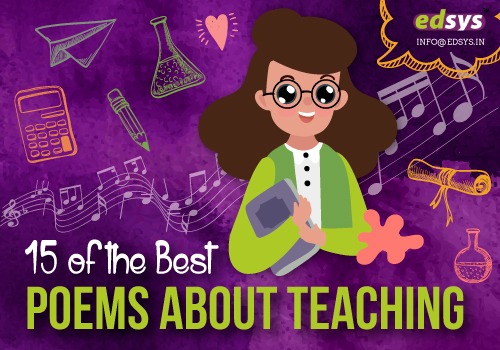An old adage says “Teaching is the one profession that creates all other professions.” It is very true. Teachers are the ones who build nations, create scientists, and nurture creative minds. In other words, teachers are the building blocks of the civilization. From school teachers to college professors and other trainers, every one has a role in building us into who and what we are.
Access Here More Than 1000+ FREE Educational Apps
In this blog, we bring to you 15 best poems about teaching. A few poems are about teachers talking about their profession, dreams, and feelings. A few others are about students describing teachers and the teaching profession. We hope you enjoy reading the poems as much as we enjoyed collating them.
1. On Teaching – Khalil Gibran
No man can reveal to you aught but that which already lies half asleep in the dawning of your knowledge.
The teacher who walks in the shadow of the temple, among his followers, gives not of his wisdom but rather of his faith and his lovingness.
If he is indeed wise he does not bid you enter the house of his wisdom, but rather leads you to the threshold of your own mind.
The astronomer may speak to you of his understanding of space, but he cannot give you his understanding.
The musician may sing to you of the rhythm which is in all space, but he cannot give you the ear which arrests the rhythm nor the voice that echoes it.
And he who is versed in the science of numbers can tell of the regions of weight and measure, but he cannot conduct you thither.
For the vision of one man lends not its wings to another man.
And even as each one of you stands alone in God’s knowledge, so must each one of you be alone in his knowledge of God and in his understanding of the earth.
Source
2. Subject to Change by Marilyn L. Taylor
A reflection on my students
They are so beautiful, and so very young
they seem almost to glitter with perfection,
these creatures that I briefly move among.
I never get to stay with them for long,
but even so, I view them with affection:
they are so beautiful, and so very young.
Poised or clumsy, placid or high-strung,
they’re expert in the art of introspection,
these creatures that I briefly move among—
And if their words don’t quite trip off the tongue
consistently, with just the right inflection,
they remain beautiful. And very young.
Still, I have to tell myself it’s wrong
to think of them as anything but fiction,
these creatures that I briefly move among—
Because, like me, they’re traveling headlong
in that familiar, vertical direction
that coarsens beautiful, blackmails young—
the two delusions we all move among.
Source
3. Transcendentalism by Lucia Perillo
The professor stabbed his chest with his hands curled like forks
before coughing up the question
that had dogged him since he first read Emerson:
Why am I “I”? Like musk oxen we hunkered
while his lecture drifted against us like snow.
If we could, we would have turned our backs into the wind.
I felt bad about his class’s being such a snoozefest, though peaceful too
a quiet little interlude from everyone outside
rooting up the corpse of literature
for being too Caucasian. There was a simple answer
to my own question (how come no one loved me,
stomping on the pedals of my little bicycle):
I was insufferable. So, too, was Emerson I bet,
though I liked If the red slayer think he slays—
the professor drew a giant eyeball to depict the Over-soul.
Then he read a chapter from his own book:
naptime.
He didn’t care if our heads tipped forward on their stalks.
When spring came, he even threw us a picnic in his yard
where dogwood bloomed despite a few last
dirty bergs of snow. He was a wounded animal
being chased across the tundra by those wolves,
the postmodernists. At any moment
you expected to see blood come dripping through his clothes.
And I am I who never understood his question,
though he let me climb to take a seat
aboard the wooden scow he’d been building in the shade
of thirty-odd years. How I ever rowed it
from his yard, into my life—remains a mystery.
The work is hard because the eyeball’s heavy, riding in the bow
Source
4. The Process of Explication By Dorothea Lasky
Students, look at this table
And now when you see a man six feet tall
You can call him a fathom.
Likewise, students when yes and you do that and other stuff
Likewise too the shoe falls upon the sun
And the alphabet is full of blood
And when you knock upon a sentence in the
Process of explication you are going to need a lot of rags
Likewise, hello and goodbye.
Nick Algiers is my student
And he sits there in a heap in front of me thinking of suicide
And so, I am the one in front of him
And I dance around him in a circle and light him on fire
And with his face on fire, I am suddenly ashamed.
Likewise the distance between us then
Is the knife that is not marriage.
Students, I can’t lie, I’d rather be doing something else, I guess
Like making love or writing a poem
Or drinking wine on a tropical island
With a handsome boy who wants to hold me all night.
I can’t lie that dreams are ridiculous.
And in dreaming myself upon the moon
I have made the moon my home and no one
Can ever get to me to hit me or kiss my lips.
And as my bridegroom comes and takes me away from you
You all ask me what is wrong and I say it is
That I will never win.
Source
5. A Teacher’s Lament by Kalli Dakos
Don’t tell me the cat ate your math sheet,
And your spelling words went down the drain,
And you couldn’t decipher your homework,
Because it was soaked in the rain.
Don’t tell me you slaved for hours
On the project that’s due today,
And you would have had it finished
If your snake hadn’t run away.
Don’t tell me you lost your eraser,
And your worksheets and pencils, too,
And your papers are stuck together
With a great big glob of glue.
I’m tired of all your excuses;
They are really a terrible bore.
Besides, I forgot my own work,
At home in my study drawer.
Source
6. To David, About His Education by Howard Nemerov
The world is full of mostly invisible things,
And there is no way but putting the mind’s eye,
Or its nose, in a book, to find them out,
Things like the square root of Everest
Or how many times Byron goes into Texas,
Or whether the law of the excluded middle
Applies west of the Rockies. For these
And the like reasons, you have to go to school
And study books and listen to what you are told,
And sometimes try to remember. Though I don’t know
What you will do with the mean annual rainfall
On Plato’s Republic, or the calorie content
Of the Diet of Worms, such things are said to be
Good for you, and you will have to learn them
In order to become one of the grown-ups
Who sees invisible things neither steadily nor whole,
But keeps gravely the grand confusion of the world
Under his hat, which is where it belongs,
And teaches small children to do this in their turn.
Source
7. Poem for Christian, My Student – by Gail Mazur
He reminds me of someone I used to know,
but who? Before class,
he comes to my office to shmooze,
a thousand thousand pointless interesting
speculations. Irrepressible boy,
his assignments are rarely completed,
or actually started. This week, instead
of research in the stacks, he’s performing
with a reggae band that didn’t exist last week.
Kids danced to his music
and stripped, he tells me gleefully,
high spirit of the street festival.
He’s the singer, of course—
why ask if he studied an instrument?
On the brink of graduating with
an engineering degree (not, it turned out,
his forte), he switched to English,
his second language. It’s hard to swallow
the bravura of his academic escapes
or tell if the dark eyes laugh with his face.
Once, he brought me a tiny persimmon
he’d picked on campus; once, a poem
about an elderly friend in New Delhi
who left him volumes of Tagore
and memories of avuncular conversation.
My encouragement makes him skittish—
it doesn’t suit his jubilant histrionics
of despair. And I remember myself
shrinking from enthusiasm or praise,
the prospect of effort-drudgery.
Success—a threat. A future, we figure,
of revision—yet what can the future be
but revision and repair? Now, on the brink
again, graduation’s postponed, the brilliant
thesis on Walker Percy unwritten.
“I’ll drive to New Orleans and soak
it up and write my paper in a weekend,”
he announces in the Honors office.
And, “I want to be a bum in daytime
and a reggae star at night!”
What could I give him from my life
or art that matters, how share
the desperate slumber of my early years,
the flashes of inspiration and passion
in a life on hold? If I didn’t fool
myself or anyone, no one could touch
me, or tell me much . . . This gloomy
Houston Monday, he appears at my door,
so sunny I wouldn’t dare to wake him
now, or say it matters if he wakes at all.
“Write a poem about me!” he commands,
and so I do.
Source
Also Read: 47 Best Poems For Kids
8. Workshop – by Billy Collins
I might as well begin by saying how much I like the title.
It gets me right away because I’m in a workshop now
so immediately the poem has my attention,
like the Ancient Mariner grabbing me by the sleeve.
And I like the first couple of stanzas,
the way they establish this mode of self-pointing
that runs through the whole poem
and tells us that words are food thrown down
on the ground for other words to eat.
I can almost taste the tail of the snake
in its own mouth,
if you know what I mean.
But what I’m not sure about is the voice,
which sounds in places very casual, very blue jeans,
but other times seems standoffish,
professorial in the worst sense of the word
like the poem is blowing pipe smoke in my face.
But maybe that’s just what it wants to do.
What I did find engaging were the middle stanzas,
especially the fourth one.
I like the image of clouds flying like lozenges
which gives me a very clear picture.
And I really like how this drawbridge operator
just appears out of the blue
with his feet up on the iron railing
and his fishing pole jigging—I like jigging—
a hook in the slow industrial canal below.
I love slow industrial canal below. All those l’s.
Maybe it’s just me,
but the next stanza is where I start to have a problem.
I mean how can the evening bump into the stars?
And what’s an obbligato of snow?
Also, I roam the decaffeinated streets.
At that point I’m lost. I need help.
The other thing that throws me off,
and maybe this is just me,
is the way the scene keeps shifting around.
First, we’re in this big aerodrome
and the speaker is inspecting a row of dirigibles,
which makes me think this could be a dream.
Then he takes us into his garden,
the part with the dahlias and the coiling hose,
though that’s nice, the coiling hose,
but then I’m not sure where we’re supposed to be.
The rain and the mint green light,
that makes it feel outdoors, but what about this wallpaper?
Or is it a kind of indoor cemetery?
There’s something about death going on here.
In fact, I start to wonder if what we have here
is really two poems, or three, or four,
or possibly none.
But then there’s that last stanza, my favorite.
This is where the poem wins me back,
especially the lines spoken in the voice of the mouse.
I mean we’ve all seen these images in cartoons before,
but I still love the details he uses
when he’s describing where he lives.
The perfect little arch of an entrance in the baseboard,
the bed made out of a curled-back sardine can,
the spool of thread for a table.
I start thinking about how hard the mouse had to work
night after night collecting all these things
while the people in the house were fast asleep,
and that gives me a very strong feeling,
a very powerful sense of something.
But I don’t know if anyone else was feeling that.
Maybe that was just me.
Maybe that’s just the way I read it.
Source
9.Teaching English from an Old Composition Book – By Gary Soto
My chalk is no longer than a chip of fingernail,
Chip by which I must explain this Monday
Night the verbs “to get;” “to wear,” “to cut.”
I’m not given much, these tired students,
Knuckle-wrapped from work as roofers,
Sour from scrubbing toilets and pedestal sinks.
I’m given this room with five windows,
A coffee machine, a piano with busted strings,
The music of how we feel as the sun falls,
Exhausted from keeping up.
I stand at
The blackboard. The chalk is worn to a hangnail,
Nearly gone, the dust of some educational bone.
By and by I’m Cantiflas, the comic
Busybody in front. I say, “I get the coffee.”
I pick up a coffee cup and sip.
I click my heels and say, “I wear my shoes.”
I bring an invisible fork to my mouth
And say, “I eat the chicken.”
Suddenly the class is alive—
Each one putting on hats and shoes,
Drinking sodas and beers, cutting flowers
And steaks—a pantomime of sumptuous living.
At break I pass out cookies.
Augustine, the Guatemalan, asks in Spanish,
“Teacher, what is ‘tally-ho’?”
I look at the word in the composition book.
I raise my face to the bare bulb for a blind answer.
I stutter, then say, “Es como delante.”
Augustine smiles, then nudges a friend
In the next desk, now smarter by one word.
After the cookies are eaten,
We move ahead to prepositions—
“Under,” “over,” and “between,”
Useful words when la migra opens the doors
Of their idling vans.
At ten to nine, I’m tired of acting,
And they’re tired of their roles.
When class ends, I clap my hands of chalk dust,
And two students applaud, thinking it’s a new verb.
I tell them delante,
And they pick up their old books.
They smile and, in return, cry, “Tally-ho.”
As they head for the door.
Source
10. John Correia, My College Chemistry Teacher by Jorge H. Aigla
The symbols of hexagons, surrounding circles
transformed into circles crossed by lines
get repeated with chalk, white on black board
many times as you talk to the young.
With the unfolding of years, you continue to stand
at the junction of the child and the man,
you give advice to those few who reach you
and help them become who they are.
Your mind offered me knowledge of things
and your outstretched hand friendship, a light
more stable than any of those bonds
by which our dark center barely holds tight.
Those lonely walks through wide teeming halls
with students who think they know what they want
should ready your soul to breathe with a sign:
it is not senseless, this passage of time.
Source
11. On Teaching the Young by Yvor Winters
The young are quick of speech.
Grown middle-aged, I teach
Corrosion and distrust,
Exacting what I must.
A poem is what stands
When imperceptive hands,
Feeling, have gone astray.
It is what one should say.
Few minds will come to this.
The poet’s only bliss
Is in cold certitude—
Laurel, archaic, rude.
Source
12. Mrs. Stein by Bill Dodds
The school bell rings, we go inside,
Our teacher isn’t there.
“Maybe she’s sick!” her pet cries out.
Yeah, right. As if I’d care.
I have a D in Language Arts,
My grade in math’s the same.
And now my teacher might be sick.
Could be I’m part to blame.
She doesn’t like me, that’s a fact,
I wouldn’t tell a lie.
She says stuff like: “You’re very smart,
But you don’t even try.”
I start to laugh—my teacher’s sick!
And boy, I’m feeling fine . . .
When someone knocks the door right in,
And there stands Frankenstein.
She’s six-foot-eight, her dress is black,
She’s wearing combat boots.
I start to gasp, she growls and says,
“I’ll be your substitute.”
The teacher’s pet is whimpering;
She doesn’t stand a chance.
The smart kid stares and points and faints.
The bully wets his pants.
“My name is Mrs. Stein,” she says,
And every student cringes.
She leans the door against the wall,
She’s knocked it off its hinges.
“Now let’s begin. You there! Stand up!”
She looks me in the eye.
I try to move, my legs won’t work.
I know I’m going to die!
In one big step she’s next to me,
And she does more than hover.
She blocks the sun, it’s dark as night,
My classmates run for cover.
“Now get up to the board,” she says.
“I’d like to see some action.
Pick up the chalk, explain to us
Division of a fraction.”
I leap away to save my life,
This time I really try.
I think and think and think and croak,
“Invert and multiply.”
“Correct! She says. I breathe again
And head back for my chair.
“You, FREEZE!” she shouts, and I stop cold.
“And don’t go anywhere.”
This all begins at nine o’clock,
I fight to stay alive.
It seems to last a million years—
The clock says nine-o-five.
That’s just three hundred seconds,
And then my turn is through.
She points at every one of us—
“Now you. Now, you. Now, you.”
We all get nailed this awful day,
There’s nowhere we can hide.
The lunch bell rings, we cannot eat,
We simply crawl outside.
We can’t believe the other kids
Who run and play their games.
Not us, who have big Mrs. Stein—
Our world is not the same.
The bell has tolled, I must go in,
My time on earth is through.
I’ll leave this on the playground—
Here’s what you have to do.
You must listen to your teacher
And pray her health is fine,
Or one day soon you’ll hear the words:
“My name is Mrs. Stein.”
Source
13. What Teachers Make by Taylor Mali
He says the problem with teachers is
What’s a kid going to learn
from someone who decided his best option in life
was to become a teacher?
He reminds the other dinner guests that it’s true
what they say about teachers:
Those who can, do; those who can’t, teach.
I decide to bite my tongue instead of his
and resist the temptation to remind the dinner guests
that it’s also true what they say about lawyers.
Because we’re eating, after all, and this is polite conversation.
I mean, you’re a teacher, Taylor.
Be honest. What do you make?
And I wish he hadn’t done that— asked me to be honest—
because, you see, I have this policy about honesty and ass-‐kicking:
if you ask for it, then I have to let you have it.
You want to know what I make?
I make kids work harder than they ever thought they could.
I can make a C+ feel like a Congressional Medal of Honor
and an A-‐ feel like a slap in the face.
How dare you waste my time
with anything less than your very best.
I make kids sit through 40 minutes of study hall
in absolute silence. No, you may not work in groups.
No, you may not ask a question.
Why won’t I let you go to the bathroom?
Because you’re bored.
And you don’t really have to go to the bathroom, do you?
I make parents tremble in fear when I call home:
Hi. This is Mr. Mali. I hope I haven’t called at a bad time,
I just wanted to talk to you about something your son said today.
To the biggest bully in the grade, he said,
“Leave the kid alone. I still cry sometimes, don’t you?
It’s no big deal.”
And that was the noblest act of courage I have ever seen.
I make parents see their children for who they are
and what they can be.
You want to know what I make? I make kids wonder,
I make them question.
I make them criticize.
I make them apologize and mean it.
I make them write.
I make them read, read, read.
I make them spell definitely beautiful, definitely beautiful, definitely beautiful
over and over and over again until they will never misspell
either one of those words again.
I make them show all their work in math
and hide it on their final drafts in English.
I make them understand that if you’ve got this,
then you follow this,
and if someone ever tries to judge you
by what you make, you give them this.
Here, let me break it down for you, so you know what I say is true:
Teachers make a goddamn difference! Now what about you?
Source
14. The Hand by Mary Ruefle
The teacher asks a question.
You know the answer, you suspect
you are the only one in the classroom
who knows the answer, because the person
in question is yourself, and on that
you are the greatest living authority,
but you don’t raise your hand.
You raise the top of your desk
and take out an apple.
You look out the window.
You don’t raise your hand and there is
some essential beauty in your fingers,
which aren’t even drumming, but lie
flat and peaceful.
The teacher repeats the question.
Outside the window, on an overhanging branch,
a robin is ruffling its feathers
and spring is in the air.
Source
15. Teachers by Kevin William Huff
Teachers
Paint their minds
and guide their thoughts
Share their achievements
and advise their faults
Inspire a Love
of knowledge and truth
As you light the path
Which leads our youth
For our future brightens
with each lesson you teach
Each smile you lengthen
Each goal you help reach
For the dawn of each poet
each philosopher and king
Begins with a Teacher
And the wisdom they bring.
Source
Access Here More Than 1000+ FREE Educational Apps
To Sum Up
Hope you have enjoyed reading these poems. So, with due respect, shower gratitude and love towards your teachers. Without these amazing people, it might have been a struggling journey for each one of us to reach where we are now today.


